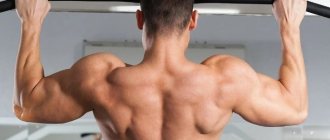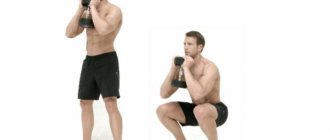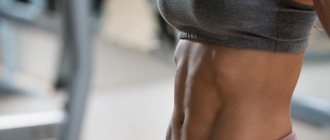When it comes to fat burning, the stomach is usually considered one of the most problematic areas. Wanting to lose weight locally in this area and gain the coveted six-pack, girls sometimes start doing abdominal workouts every day and often get the opposite result: the centimeters somehow increase, or the exercise program simply has minimal effect. Let's figure out how to train correctly and as efficiently as possible.
- Features of the structure of the abdominal muscles
- A set of exercises to pump up the abs for men and women
- Straight crunches
- Video: The process of performing straight crunches
- Heel touch
- Video: Heel touch technique
- Knee pull-up in plank
- Fold
- Video: Fold technique
- Abdominal training program at home
- Program “200 press” - schedule for performing approaches
- Table: Program “200 press”
- “30 days” program – training system schedule for a month
- Table: Abdominal training program “30 days”
- Recommendations for performing abdominal exercises
Features of the structure of the abdominal muscles
All people have generally the same structure of abdominal muscles - we all have the same set of muscle groups - but the appearance of the abs may vary slightly.
The appearance of the press is individual for each person, but for everyone it includes certain muscle groups.
The abdominal muscles include the following:
The rectus muscle is the longest muscle of the anterior abdominal wall, which begins at the pubic crest and attaches to the ribs and sternum. Several tendons - usually three or four - stretch its muscle fibers, forming the well-known abs.
The rectus muscle allows the body to fully bend forward and the pelvis to rise.
The external oblique muscle is the widest of the abdominal muscles. Its fibers stretch obliquely along the abdomen and partly the chest.
This muscle provides flexion of the body. With unilateral contraction, the muscle turns the body in the opposite direction.
The internal oblique muscle is a muscle that is part of the second layer of the abdominal wall and is located under the external oblique. Its fibers also run obliquely, but from bottom to top.
The functional component includes flexion of the body during bilateral muscle contraction, lifting of the pelvis and rotation of the body in the appropriate direction during unilateral contraction.
The transverse muscle is a muscle that forms the deepest, third, layer of the abdominal wall. Her buns are in a horizontal position and wrap around the waist.
In the process of muscle contraction, it is the transverse abdominal muscle that reduces the volume of the abdominal cavity, allows you to tighten the abdomen and bring the ribs to the midline.
Types of tables
After collecting all the necessary things, you need to select a table suitable for training, this will be your training program. There are several different schemes by which you can start training:
- Timed training. This table indicates the time spent on each exercise and the number of repetitions. This scheme assumes high speed of work and correct execution of each exercise, despite the speed of the workout.
- Training by number of repetitions. From the name it is clear that in this case every exercise matters. Do not neglect the last approach or the last repetition, citing its insignificance.
A set of exercises to pump up the abs for men and women
To increase the effectiveness of pumping and each exercise, it is necessary to keep the stomach in good shape all the time during their implementation, slightly retracting it.
Straight crunches
This variation of crunches primarily works the upper abdominal area.
- Starting position - lying on a gymnastic mat, slightly bend your knees, and place your feet firmly on a horizontal surface. It is better to clasp your hands together and move them behind your head. The abdominal muscles remain toned until the end of the approach.
- We do a twist (as you exhale) - bring the ribs in the direction of the hips, while tearing off only the shoulder blades.
- While inhaling, return to the starting position.
- Continue crunches until you complete the set.
During the entire approach, you need to keep your abs tense.
It is recommended to perform 10 repetitions for each of 2-3 approaches.
Video: The process of performing straight crunches
Heel touch
This exercise works the oblique abdominal muscles.
- Starting position - lying on a gymnastic mat on your back, bend your knees, fix your feet on a horizontal surface at the level of your shoulder width. Extend your arms along your body, palms down.
- Slightly raise your upper body and try to touch the heel of the same name with each hand.
- Perform 15 repetitions on each side. It is recommended to do 3-4 approaches.
Try not to pull your chin to your chest too much, do not overstrain your neck.
ve
Video: Heel touch technique
Knee pull-up in plank
Also called the rock climber, this exercise provides an active lower abdominal workout for both men and women.
- Starting position - plank with emphasis on the palms. The body should be completely straight, the pelvis should not bend or rise.
- Bend your right leg and pull your knee towards your right elbow.
- We return to the starting position.
- We repeat the same thing, but with the left leg.
- We return to the starting position.
- We continue to alternately pull up the knees in the plank until the approach is completed.
It is recommended to do 7-8 repetitions for each of three to four sets.
P
Another version of the “climber” is when the knee reaches towards the opposite elbow. This option uses the oblique abdominal muscles more.
A
Fold
Trains all areas of the rectus abdominis muscles.
- Starting position - lying on your back, arms extended behind your head, legs together.
- As you exhale, we fold, while trying to connect our fingers and toes in the middle.
- While inhaling, we return to the starting position.
- We continue to perform the fold until the approach is completed.
ENT
It is advisable to perform this exercise 7–10 times for each of 2–3 approaches.
Video: Fold technique
Content
- 1 Ab workout program for home
- 2 Pull your knees to your chest
- 3 Knee raises from a lying position
- 4 Bent leg raises from a lying position
- 5 Frog Leg Raises
- 6 Straight leg raises from a lying position
- 7 Hanging Knee Raises
- 8 Hanging Bent Leg Raises
- 9 Hanging leg raises - “frog”
- 10 Partial hanging straight leg raises
- 11 Straight hanging raises
- 12 Outside the program
- 13
Abdominal training program at home
Home workout programs aimed at strengthening your abdominal muscles help you strengthen your abs and reduce the likelihood of your waist becoming larger.
Program “200 press” - schedule for performing approaches
The essence of this program is as follows: training the abdominal muscles with a gradual increase in the number of repetitions, the end result of which we should be able to perform 200 sit-ups in one approach.
Before you begin the program itself, you need to identify your current level of physical fitness. To do this, you need to complete the maximum number of lifts in one approach.
So, if you were able to lift your body 15 times or less, your level is beginner . When lifting the body from 16 to 25 times, your physical fitness corresponds to the average level. experienced will be able to lift his body 26 or more times .
The program is designed for six weeks, in each of which you should exercise for three non-consecutive days - on the rest you need to give your muscles rest. The table shows the schedule (schedule) for performing exercises to pump up the abs for both beginners and more advanced ones.
Table: Program “200 press”
| A week | Day | Level of training | First approach | Second approach | Third approach | Fourth approach | Fifth approach | Total reps |
| 1 | 1 | Beginner Intermediate Experienced | 3 9 15 | 4 10 16 | 3 5 10 | 3 5 10 | 5 8 14 | 18 37 65 |
| 2 | Beginner Intermediate Experienced | 5 10 16 | 6 13 17 | 3 9 15 | 5 8 14 | 5 10 18 | 24 50 80 | |
| 3 | Beginner Intermediate Experienced | 6 11 18 | 8 14 23 | 5 10 15 | 5 10 15 | 8 15 23 | 32 60 94 | |
| 2 | 1 | Beginner Experienced Intermediate | 5 15 21 | 9 17 22 | 5 13 17 | 6 12 15 | 9 17 22 | 34 82 97 |
| 2 | Beginner Experienced Intermediate | 6 15 20 | 9 19 24 | 6 15 20 | 7 16 21 | 10 20 26 | 38 85 111 | |
| 3 | Beginner Experienced Intermediate | 7 19 26 | 12 20 25 | 5 15 20 | 5 15 20 | 12 23 31 | 41 92 122 | |
| 3 | 1 | Beginner Experienced Intermediate | 15 17 20 | 19 25 30 | 15 20 35 | 10 20 23 | 10 20 23 | 69 102 131 |
| 2 | Beginner Experienced Intermediate | 17 20 30 | 20 30 40 | 12 21 23 | 12 21 23 | 17 25 35 | 78 117 151 | |
| 3 | Beginner Experienced Intermediate | 20 21 33 | 23 30 37 | 12 22 25 | 11 21 26 | 21 32 38 | 87 126 159 | |
| 4 | 1 | Beginner Experienced Intermediate | 20 25 23 | 21 33 38 | 18 25 33 | 16 25 32 | 24 38 48 | 99 146 174 |
| 2 | Beginner Experienced Intermediate | 20 35 38 | 24 38 45 | 20 30 40 | 18 30 38 | 25 40 55 | 107 173 216 | |
| 3 | Beginner Experienced Intermediate | 23 35 45 | 25 42 50 | 27 40 36 | 18 25 45 | 32 46 58 | 125 188 234 | |
| 5 | 1 | Beginner Experienced Intermediate | 33 46 60 | 32 54 64 | 23 37 47 | 25 35 40 | 19 23 33 | 132 197 244 |
| 2 | Beginner Experienced Intermediate | 30 44 55 | 30 44 55 | 40 50 62 | 40 60 62 | 15 21 25 | 155 219 259 | |
| 3 | Beginner Experienced Intermediate | 36 42 50 | 36 42 50 | 44 57 69 | 44 57 69 | 18 27 38 | 178 225 276 | |
| 6 | 1 | Beginner Experienced Intermediate | 35 50 65 | 45 67 75 | 30 56 72 | 30 35 45 | 45 30 32 | 185 238 289 |
| 2 | Beginner Experienced Intermediate | 42 50 56 | 42 50 56 | 46 65 75 | 46 65 75 | 21 28 34 | 197 258 296 | |
| 3 | Beginner Experienced Intermediate | 45 50 68 | 45 50 68 | 48 77 89 | 50 56 72 | 20 30 40 | 208 263 337 |
After completing the proposed program, give your muscles time to recover - about two to three days - and then try to lift your body 200 times in one approach. There is a good chance that you will be able to do about 170-180 sets - this is normal. In such a situation, the program should be repeated, but from the fourth week.
“30 days” program – training system schedule for a month
The essence of the 30-day program for pumping up the abs is to perform a set of suggested exercises several times a day. Such training should be repeated daily for 30 days, according to the program.
We will perform a set of those abdominal exercises that were discussed above. One continuous performance of each exercise represents one circuit.
Monthly exercise plan.
Table: Abdominal training program “30 days”
| Day | Number of circuits and repetitions during the day |
| 1 | 6 laps, 1 rep |
| 2, 3 | 6 laps, 2 reps |
| 4, 5, 6 | 6 laps, 4 reps |
| 7, 8, 9, 10 | 8 laps, 3 reps |
| 11, 12, 13, 14 | 10 laps, 4 reps |
| 15, 16, 17, 18 | 10 laps, 3 reps |
| 19, 20, 21, 22 | 12 laps, 4 reps |
| 23, 24, 25, 26 | 12 laps, 3 reps |
| 27, 28, 29, 30 | 14 laps, 4 reps |
After completing the program, you can continue to train according to the same scheme, increasing the number of laps. The appearance of cubes is promoted not by the amount of effort exerted during work, but by the time spent. The longer you train, the closer you get to your goal.
Outside the program[edit | edit code]
For most athletes, even very talented ones who progress quite quickly, leg raises provide a lot of scope for productive training. All exercises in this program can be modified and adapted to suit each individual's individual needs (see descriptions in the Improving Technique section), turning each exercise into a variety of different movements. Gradually increasing the difficulty will help build muscles and significantly strengthen them. By the time you reach the master level, you will find relief cubes on your stomach, if that's what you were aiming for. One way or another, don't stop there. Increase your reps to fifty—that's a heck of a goal, but not unthinkable.
The average athlete should be incredibly proud of such an achievement, and there is no shame in dwelling on it. This achievement is light years ahead of anything a gym-trained zombie can achieve. But some of you will want to go further. If you are one of this elite group, I would encourage you to take a look at the most powerful abdominal exercise, the V-leg raise.
Bruce Lee's favorite V-leg raises are rarely performed in gyms, but are more often performed by professional gymnasts. It takes years of rigorous and focused training to improve muscle strength, nervous system, coordination and flexibility to perfectly perform these undeniably effective abdominal lifts.
In classic leg raises, straight legs are perpendicular to the body; in V-shaped leg raises, the legs are raised as high as possible - the legs and body form a sharper angle, that is, visually reminiscent of the letter “V” (hence the name). It's actually easier said than done. To perform this exercise, not only must the abdominal muscles have tremendous strength, but also the thigh muscles must be made of steel. And if your glutes, biceps, and spinal muscles aren't strong enough, don't even try this exercise.
However, if you are doing an elite-level training routine of hanging straight leg raises, try starting to train V-raises. Do not combine classic and V-lifts in one workout; move the V-lifts to another day when the muscles are still fresh. Before doing V-lifts, warm up thoroughly and do some flexibility exercises, and initially perform the exercise while sitting on the floor. Sit on the floor and, supporting yourself with your hands, raise your legs as high as possible. Lean back slightly and lift until your legs and body are in a V-shape. It will be hard at first: you will feel crazy tension in your abdominal muscles and thighs - they have probably never had to be in this position in their life. Never swing or use momentum. Only the muscles should work - watch this. Once you understand the technique, try to do 20 repetitions. After this, begin performing V-shape raises with a straight back. It will be hard. And as soon as you overcome the 20-repetition bar, complicate the exercises by starting to perform them in a half-hang - between two chairs.
Stand between two chairs, lean on the backs. Keep your body straight, legs extended forward, heels on the floor. Then perform V-lifts. Of course, your legs won't hang straight down; the chairs aren't tall enough for that. This is a transition exercise that will help you practice your hanging raise technique. Always slowly lift your legs up until they reach a V-shape. Keep your legs straight and your muscles tense. Repeat 20 times.
By carefully working through all the steps, you will prepare your muscles for full hanging V-raises.
Recommendations for performing abdominal exercises
Tips on efficiency and warnings against mistakes will allow you to achieve excellent results in minimal time.
- When performing any abdominal exercise, it is very important to consciously engage the abdominal muscles: do not completely relax the muscles, even when you are in the least active phase of the exercise.
- It is necessary to perform abdominal exercises at a slow pace, focusing on technique.
- You can speed up the process of getting sculpted abs by regularly introducing new exercises. This is explained by the rapid adaptation of the abdominal muscles to the proposed load. If you train yourself with the same exercises, their effectiveness will decrease over time.
- When working on your abdominal muscles, you can't ignore nutrition. If you are overweight and you do not reduce the amount of calories you consume, the relief simply will not appear through the fat layer.
- Before each workout, a 5-10 minute warm-up is required. This could be, for example, running in place or jumping rope.
- You are allowed to rest for a maximum of one minute between approaches.
So, in order to achieve impressive and strong abs, you need to approach training wisely: regularly perform a balanced set of exercises for all abdominal muscles, while giving them time to recover. And, of course, adjust your diet in accordance with the principles of proper nutrition.
How to perform the complex
This workout includes six of the most effective exercises, divided into three trisets (mini complexes of three different movements). Therefore, you will do exercises 1A, 1B and 1C in order, performing all reps in the indicated mode, and rest only after completing all reps of 1C. You'll complete three circuits of the first triset, then move on to the second triset, doing exercises 2A, 2B, and 2C in the same way.
To make progress faster, tighten your abs before starting the first rep of each set. By going into exercise with your target muscles activated, you will maintain proper form throughout the entire set, thereby better training your muscles.
How to supplement homework?
There are a number of mandatory conditions, without which there is no point in training. This:
- proper, balanced nutrition;
- refusal of strict diets;
- clear daily routine.
Dietary restrictions combined with active physical activity will give the opposite result - instead of losing weight, the athlete will begin to actively gain weight. This is due to the body’s reflexes: personal reserves disappear, food is not supplied, which means that you need to actively stock up on what enters the body. Therefore, leaving the diet before starting training is mandatory.
The diet must be complete, providing the body with a complete supply of energy. The main thing is to give up foods that contain fast, empty carbohydrates.
You need to exclude sweets, flour products, and fast food from the menu. Preference should be given to protein products, grains, and gifts of nature. They must be prepared in such a way that they are subjected to minimal heat treatment. You need to eat often, but in small portions.
The main thing is that the body is satiated, since the feeling of hunger is a bad helper in sports. The basic rule of proper nutrition is to consume fewer calories than you expend. Only in this way will the body begin to release its fat reserves, which will contribute to weight loss in the right places.
Another important condition for losing excess weight is the load on the heart. It is provided by aerobic exercise: cycling, running, race walking, swimming, skiing. If it is not possible to engage in these sports, and buying a simulator is too expensive, then a jump rope, which is inexpensive, and has enormous benefits, will save you.
Thus, 15 minutes of training with a jump rope is comparable to the load received when covering half a marathon distance. Moreover, during jumping, absolutely all the muscles of the body work, including the heart, so a jump rope can easily replace any exercise machine.
The right diet for results
It is very important to adhere to proper nutrition in everyday life, and it is better to make it a natural part of your daily routine. But we will consider the nutrition factor in the paradigm of this program as one of the fundamental points. Below are lists of products that affect the program.
So, we completely exclude from the diet:
- Alcoholic drinks, coffee, strong tea.
- Flour made from white flour;
- Products containing yeast;
- Honey, sugar, any sweets from the store;
- Potato;
- Products containing starch;
- Fast food and fast food places.
- Fried.
- Semi-finished products.
We include in the diet:
- Drink clean water throughout the day (still).
- Fresh lemon (if there are no health contraindications).
- Salads from vegetables and herbs.
Don't be scared! This does not mean that the lists above limit you forever. But during the 30-day ab pumping program, this is counter-important.
Pay attention to proper rest
It is important to allow the body to rest and fully recover after training. This means that you should sleep at least 8 hours a day , no less. In case of non-compliance with sleep patterns and lack of proper rest, metabolic and functional processes in the body are disrupted.
In addition, if a person does not follow a sleep schedule and does not sleep enough, then he becomes lethargic, slow, the motivation to act disappears and overall activity decreases sharply. Take this information into account and avoid mistakes that lead to decreased performance and injury.











